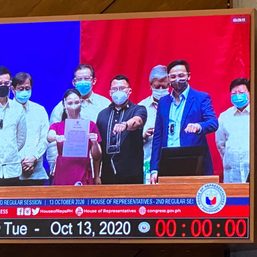SUMMARY
This is AI generated summarization, which may have errors. For context, always refer to the full article.

MANILA, Philippines – The Philippine government will be borrowing even more this year, as revenue collection is expected to drop by as much as P91 billion due to the economic slowdown triggered by the novel coronavirus.
In a press briefing on Tuesday, March 10, Finance Secretary Carlos Dominguez III said the budget deficit may hit as high as 3.6% of the country’s gross domestic product (GDP), assuming that the economic impact of the virus would last until June.
Dominguez said the increased borrowings would help sustain President Rodrigo Duterte’s ambitious Build, Build, Build infrastructure program.
Socioeconomic Planning Secretary Ernesto Pernia said the economic team programmed the ceiling for the budget deficit to hit a maximum of 3% for 2020.
Pernia added that economic growth may fall by a full percentage point due to the economic slowdown. This means that the government may miss its GDP target of 6.5% to 7.5% for this year. (READ: ‘A mess’: Coronavirus economic impact on Philippines worse than projected)
Lower tourism-related activities and weaker trade are the main contributors for the economic slowdown.
Why does this matter? A budget deficit shows the government is spending beyond its means.
In 2019, the budget deficit exploded to 3.5%, higher than the target of 3.25%. It was the second time in Philippine history that the annual deficit surpassed the ceiling set by the government.
The rise was due to the aggressive increase in spending in the 4th quarter, with the budget deficit soaring to 6.8%. (READ: [ANALYSIS] How the budget deficit exploded under Duterte’s watch)
Meanwhile, the Bureau of Internal Revenue did not reach the tax collection target last year. It only collected P2.17 trillion, which was below the P2.33-trillion target.
As the government fails to reach its revenue targets, it will have little option but to borrow and incur more debt.
The deficit figure is also dependent on GDP growth. Simply put, the lower the GDP, the less room for government to borrow in the future.
Will the Philippines’ debt be too much? Data from the Bureau of the Treasury showed that the country’s debt soared to P7.7 trillion in 2019.
But so far, the debt-to-GDP ratio is at 41.9%, still within the government target of 42%.
The ratio simply compares what the country owes with what it produces, and indicates the country’s ability to pay back its debts.
“Our credit rating is quite robust and we don’t expect any difficulty in covering for potential deficit that might occur because of the expected drop in economic activity because of this COVID,” Dominguez said. – Rappler.com
Add a comment
How does this make you feel?




![[PODCAST] Beyond the Stories: Ang milyon-milyong kontrata ng F2 Logistics mula sa Comelec](https://www.rappler.com/tachyon/2021/11/newsbreak-beyond-the-stories-square-with-topic-comelec.jpg?resize=257%2C257&crop_strategy=attention)





![[EDITORIAL] Ang low-intensity warfare ni Marcos kung saan attack dog na ang First Lady](https://www.rappler.com/tachyon/2024/04/animated-liza-marcos-sara-duterte-feud-carousel.jpg?resize=257%2C257&crop=294px%2C0px%2C720px%2C720px)
![[Free to disagree] How to be a cult leader or a demagogue president](https://www.rappler.com/tachyon/2024/04/TL-free-to-disagree.jpg?resize=257%2C257&crop_strategy=attention)
![[OPINION] Can Marcos survive a voters’ revolt in 2025?](https://www.rappler.com/tachyon/2024/04/tl-voters-revolt-04042024.jpg?resize=257%2C257&crop=251px%2C0px%2C720px%2C720px)
![[Edgewise] Quo vadis, Quiboloy?](https://www.rappler.com/tachyon/2024/03/quo-vadis-quiboloy-march-21-2024.jpg?resize=257%2C257&crop_strategy=attention)
There are no comments yet. Add your comment to start the conversation.